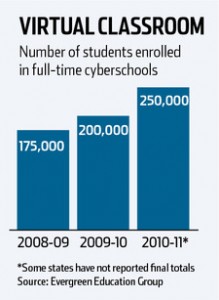The Wall Street Journal recently published a very interesting article on the state of online learning in the U.S. today. It talked primarily about e-learning and its growth among students in school grades K-12, comparing the progress of students in these online programs to their traditionally educated peers in physical classrooms.
students in these online programs to their traditionally educated peers in physical classrooms.
While none of our clients fall into the K-12 age group category, we thought it was interesting to note the increase in the numbers of parents that opt for this medium for their kids’ education, given how new it is and how connected the physical classroom has become with learning.
The results were widely varied and worth sharing. The studies cited in the article state that students who are enrolled full time in an online education program tend to score lower in standardized testing than those enrolled full time in a physical classroom. Representatives from online education providers say these numbers can be misleading because students often enroll mid-year and take the tests after just a few months in the online programs. Statistics that show the longer students are enrolled in online programs the better they do back up this argument.
However, many schools are employing a physical classroom / virtual classroom hybrid, where much of the classes are taken online but the students still come in to a physical classroom for special assignments, hands on projects or teacher meetings. These students tend to be at par with, or even outscore their physical-classroom-only peers.
From the article:
In California for example, a chain of charter hybrid schools that serves mostly poor and minority kids, has produced state test scores on par with some of the states wealthiest schools.
We were also surprised at the amount of states that have begun adopting online education programs as part of their public  school curriculum. Nationwide, there is an estimated 250,000 students enrolled in full-time virtual schools. This is an increase of 40% in the last three years! More than 2 million students take at least one class online, according to an industry trade group.
school curriculum. Nationwide, there is an estimated 250,000 students enrolled in full-time virtual schools. This is an increase of 40% in the last three years! More than 2 million students take at least one class online, according to an industry trade group.
From the article:
In just the last few months, Virginia has authorized 13 new online schools. Florida began requiring all public-high-school students to take at least one class online, partly to prepare them for college cybercourses. Idaho will require two. In Georgia, a new app lets high-school students take entire course loads on their iPhone or Blackberry. Thirty states now let students take all of their courses online.
We suspect that a probable reason for the poor testing results of online-only students shown by some studies is that a good portion of the students enrolled in the online-only programs did not have sufficient motivation to learn.
However, as you get older, and have graduated from school into a real-world job, taking additional courses or training can often lead to career advancement and, hopefully, more opportunities and better pay. This certainly provides the learner with the proper motivation to do well in the courses they decide to take. It is why we feel that online learning for professional advancement and career training is a great option to those looking for a relatively inexpensive (when compared to a classroom equivalent), yet effective means of getting the training, certification, or general subject matter knowledge that a learner needs. Now, this assumes that the online course is built and delivered effectively. However, not all online education is equal, but that is a topic for another time.
The Internet is not going away. In fact, it is going to become more and more a part of our lives – like it or not – in ways that we cannot fathom, even today. The statistics cited in the article above are indicative of the future of learning. We may never get to a point where physical classroom presence for necessary hands on training is not required, but we will certainly get to a point where the majority of our learning can be done remotely, conveniently, and at our own pace – online.



